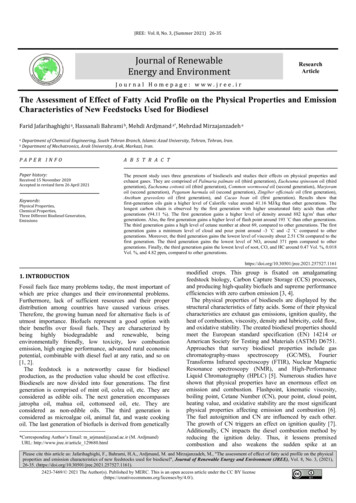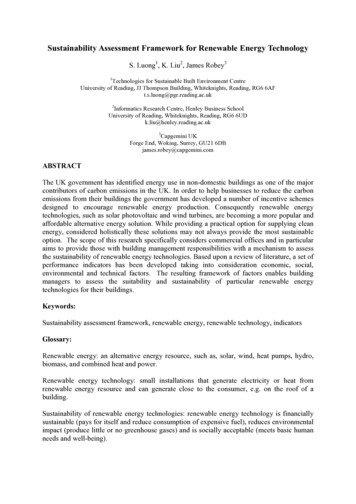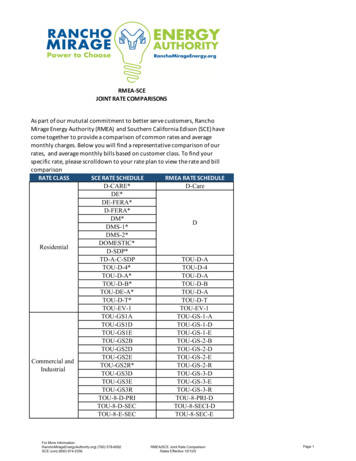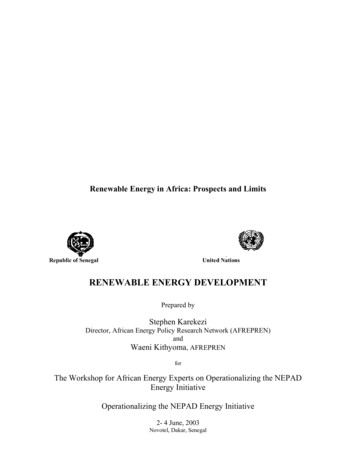
Transcription
JREE: Vol. 8, No. 3, (Summer 2021) 26-35Journal of RenewableEnergy and EnvironmentResearchArticleJournal Homepage: www.jree.irThe Assessment of Effect of Fatty Acid Profile on the Physical Properties and EmissionCharacteristics of New Feedstocks Used for BiodieselFarid Jafarihaghighi a, Hassanali Bahrami b, Mehdi Ardjmand a*, Mehrdad Mirzajanzadeh aabDepartment of Chemical Engineering, South Tehran Branch, Islamic Azad University, Tehran, Tehran, Iran.Department of Mechatronics, Arak University, Arak, Markazi, Iran.PAPER INFOA B S T R A C TPaper history:The present study uses three generations of biodiesels and studies their effects on physical properties andexhaust gases. They are comprised of Palmaria palmate oil (third generation), Eucheuma spinosum oil (thirdgeneration), Eucheuma cottonii oil (third generation), Common wormwood oil (second generation), Marjoramoil (second generation), Peganum harmala oil (second generation), Zingiber officinale oil (first generation),Anethum graveolens oil (first generation), and Cacao bean oil (first generation). Results show thatfirst-generation oils gain a higher level of Calorific value around 41.16 MJ/kg than other generations. Thelongest carbon chain is observed by the first generation with higher unsaturated fatty acids than othergenerations (94.11 %). The first generation gains a higher level of density around 882 kg/m3 than othergenerations. Also, the first generation gains a higher level of flash point around 193 C than other generations.The third generation gains a high level of cetane number at about 69, compared to other generations. The firstgeneration gains a minimum level of cloud and pour point around -3 C and -2 C compared to othergenerations. Moreover, the third generation gains the lowest level of viscosity about 2.51 CSt compared to thefirst generation. The third generation gains the lowest level of NOx around 371 ppm compared to othergenerations. Finally, the third generation gains the lowest level of soot, CO, and HC around 0.47 Vol. %, 0.018Vol. %, and 4.82 ppm, compared to other generations.Received 15 November 2020Accepted in revised form 26 April 2021Keywords:Physical Properties,Chemical Properties,Three Different Biodiesel 2021.257527.11611. INTRODUCTION *Fossil fuels face many problems today, the most important ofwhich are price changes and their environmental problems.Furthermore, lack of sufficient resources and their properdistribution among countries have caused various crises.Therefore, the growing human need for alternative fuels is ofutmost importance. Biofuels represent a good option withtheir benefits over fossil fuels. They are characterized bybeing highly biodegradable and renewable, beingenvironmentally friendly, low toxicity, low combustionemission, high engine performance, advanced rural economicpotential, combinable with diesel fuel at any ratio, and so on[1, 2].The feedstock is a noteworthy cause for biodieselproduction, as the production value should be cost effective.Biodiesels are now divided into four generations. The firstgeneration is comprised of mint oil, colza oil, etc. They areconsidered as edible oils. The next generation encompassesjatropha oil, mahua oil, cottonseed oil, etc. They areconsidered as non-edible oils. The third generation isconsidered as microalgae oil, animal fat, and waste cookingoil. The last generation of biofuels is derived from genetically*Corresponding Author’s Email: m arjmand@azad.ac.ir (M. Ardjmand)URL: http://www.jree.ir/article 129680.htmlmodified crops. This group is fixated on amalgamatingfeedstock biology, Carbon Capture Storage (CCS) processes,and producing high-quality biofuels and supreme performanceefficiencies with zero carbon emission [3, 4].The physical properties of biodiesels are displayed by thestructural characteristics of fatty acids. Some of their physicalcharacteristics are exhaust gas emissions, ignition quality, theheat of combustion, viscosity, density and lubricity, cold flow,and oxidative stability. The created biodiesel properties shouldmeet the European standard specification (EN) 14214 orAmerican Society for Testing and Materials (ASTM) D6751.Approaches that survey biodiesel properties include gaschromatography-mass spectroscopy (GC/MS), FourierTransforms Infrared spectroscopy (FTIR), Nuclear MagneticResonance spectroscopy (NMR), and High-PerformanceLiquid Chromatography (HPLC) [5]. Numerous studies haveshown that physical properties have an enormous effect onemission and combustion. Flashpoint, kinematic viscosity,boiling point, Cetane Number (CN), pour point, cloud point,heating value, and oxidative stability are the most significantphysical properties affecting emission and combustion [6].The fuel autoignition and CN are influenced by each other.The growth of CN triggers an effect on ignition quality [7].Additionally, CN impacts the diesel combustion method byreducing the ignition delay. Thus, it lessens premixedcombustion and also weakens the sudden spike at anPlease cite this article as: Jafarihaghighi, F., Bahrami, H.A., Ardjmand, M. and Mirzajanzadeh, M., "The assessment of effect of fatty acid profile on the physicalproperties and emission characteristics of new feedstocks used for biodiesel", Journal of Renewable Energy and Environment (JREE), Vol. 8, No. 3, (2021),26-35. 423-7469/ 2021 The Author(s). Published by MERC. This is an open access article under the CC BY 0/).
F. Jafarihaghighi et al. / JREE: Vol. 8, No. 3, (Summer 2021) 26-35in-cylinder temperature, which is responsible for enhancingthe predisposition of thermal NO [8]. Hence, improving theCN triggers lessening the NO concentration. Folayan et al.indicated that palm kernel and coconut oil had upper pour andcloud point, low-temperature filterability, and cold filterplugging point and examination point compared to linoleicand oleic oils, which caused poor cold flow conduct. This isbecause these properties are considerably enhanced with agreater degree of unsaturation, longer carbon chain, andhigher degrees of branching. Saponification number droppedwith molecular weight and chain length. The iodine valuerises as the mark of unsaturation rises, but drops with chainlength. They also indicated the effect of fatty acids on CN,heating value, and density [9]. Marlina et al. worked on fattyacids and their results showed that polar fatty acids werefurther reactive because of electric charge. Bent and longpolar fatty acids were more reactive than the straight and shortpolar ones, as the former had durable higher and polarityelectron mobility. The uppermost electron mobility causedmolecules to be less tight; therefore, evaporation levelincreased. The presence of more than one double bond inpolyunsaturated oil partly inhibited electron mobility. Quickerevaporation level caused ignition temperature to decrease,meanwhile heat energy was altered in latent heat for stagechange over evaporation [10]. Jafarihaghighi et al. usedseveral samples and showed that the physical propertiesaffected emissions. They showed that the structure of fattyacids decreased or increased physical properties and had adirect effect on exhaust emissions [11].In this paper, the main objective is to show the physicalproperties and exhaust gases of three different generations ofbiodiesel under the same conditions to demonstrate whichgeneration will have better efficiency and better outcomes. Allthe oils used are new to give a new perspective and eliminatethe exclusivity of certain groups. In this path, the length ofchains, ratio of hydrogen to carbon, oxygen to carbon,saturated acids, and unsaturated acids of the three generationsare examined and compared. One of the most importantreasons for choosing different generations in this report is thatthey have the ability to grow in harsh conditions in the MiddleEast and Iran, and that an attempt is made to show whichfuture generation is better for use.2. MATERIALS AND METHODSNine different oils from three different generations wereconsidered. They include Palmaria palmata oil (thirdgeneration), Eucheuma spinosum oil (third generation),Eucheuma cottonii oil (third generation), Common wormwoodoil (second generation), Marjoram oil (second generation),Peganum harmala oil (second generation), Zingiber officinaleoil (first generation), Anethum graveolens oil (firstgeneration), and Cacao bean oil (first generation). Themethanol (99 %) and KOH (99 %) were supplied by AldrichChemical Co. (USA).The transesterification technique was applied to the samples.Biodiesel samples were created through the KOH-catalyzedtransesterification reaction at a level of 1 to 3 (v/v) formethanol-to-oil. Therefore, they were completed in thepresence of KOH as the acid catalyst for around 1 h at55-60 C. Between one to two hours was adequate to separatethe solution for eliminating methanol-water at the top stage.Then, in the bottom stage, the value of the acid level wascalculated. The yields of biodiesel produced for first, second,27and third generations of biodiesel were around 85-90 %, 89-95%, and 93-95 %, respectively. All biodiesels were composedby a combination of 20 % net biofuel with 80 % diesel [1].The flashpoint was calculated according to ASTM standardD93. The level of viscosity and value of density weredetermined with Stabinger Viscometer, Anton Paar,SVM3000 model (Anton Paar Co., Austria). The viscositywas also assessed by ASTM-D445. The flashpoint wascalculated with the Constantly Close Cup Flash Point(CCCFP) tester applying the Grabner FLPH Miniflash Tester(Grabner, Austria). The level of cloud point was assessed bythe s/500 (Italian) model, compliant with the ASTM standardD2500. Sediment and water measurements were completed byKarl Fischer setup, metrohm, 794 Basic Titrino sterification, were specified by Gas Chromatography(GC, Claus 580 GC model, Perkin Elmer Co., USA). Thelevel of CN was shown by the Octan-IM device.In this research, a 3LD 510 model was used for a12-horsepower single-cylinder diesel engine manufactured bythe Italian Lombardy Company. Its specifications are shownin Table 1. The dynamometer Eddy Current WE400 modelfrom Pars Andish Innovative Company (MPA) was employedto measure the torque, rotational speed, and power of the 3LD510 Diesel Engine. Specifications of the MAHA-MGT5analyzer used in the test are shown in Table 2. The test wascarried out at 2000 rpm and full load.Table 1. The engine er of cylinders1Bore and stroke (mm)85 90Displacement(cm3)510AspirationNaturally aspiratedCycle4 strokeCombustion systemDirect InjectionRotationCounter-clockwise (view frommain PTO side)Cooling systemAirFuel tank capacity (l)5.3Oil sump capacity (l)1.75Length (mm)466Width (mm)422Height (mm)568Dry weight (kg)60Cylinder course (mm)90Cylinder diameter (mm)85Cylinder volume(cm3)Maximum power hp (300051012.2rpm)Maximum torque 1800rpm33(Nm)Compression ratio17.5:1
28F. Jafarihaghighi et al. / JREE: Vol. 8, No. 3, (Summer 2021) 26-35acids and also the highest unsaturated acids were Linoleicacids. The highest saturated acids for Marjoram oil werePalmitic acids and also the highest unsaturated acids wereOleic acids. The highest saturated acids for Peganum harmalaoil were Palmitic acids and also the highest unsaturated acidswere Oleic acids. The highest saturated acids for Palmariapalmata oil were Palmitic acids and also the highestunsaturated acids were Oleic acids. The highest saturatedacids for Eucheuma spinosum oil were Palmitic acids and alsothe highest unsaturated acids were Linoleic acids. The highestsaturated acids for Eucheuma cottonii algae oil were Palmiticacids and also the highest unsaturated acids were Oleic acids.The highest saturated acids for Zingiber officinale oil werePalmitic acids and also the highest unsaturated acids wereOleic acids. The highest saturated acids for Anethumgraveolens oil were Palmitic acids and also the highestunsaturated acids were Oleic acids. The highest saturatedacids for Cacao bean oil were Palmitic acids and also thehighest unsaturated acids were Oleic acids.Obviously, in Fig. 1, the longest carbon chain presented toAnethum graveolens biodiesel (C18-C24) was around94.11 %. Common wormwood displayed a long carbon chain(C18-C22) around 93.35 %. Next, Peganum harmaladisplayed a long carbon chain (C18-C22) around 88.93 %.Cacao bean oil displayed a long carbon chain (C18-C20)around 88.47 %. Subsequently, Marjoram oil displayed a longcarbon chain (C18-C22) around 86.73 %. Zingiber officinaleoil displayed a long carbon chain (C18-C20) around 84.52 %.Palmaria palmata oil displayed a long carbon chain(C18-C22) around 80.19 %. Eucheuma spinosum oil displayeda long carbon chain (C18-C22) around 70.60 %. Finally,Eucheuma cottonii algae oil displayed a long carbon chain(C18-C20) around 58.40 %.The presence of fatty acids in biodiesel can affect the rate ofoxygen to carbon (O/C) and hydrogen to carbon (H/C).Vividly, the enhancement of fatty acids affects the amount ofoxygen in the process. On the other hand, the amount ofhydrogen can be altered by fatty acids. Therefore, the growthof saturated acids triggers the increase of hydrogen in theprocess. Hence, the maximum saturated acids, O/C, and H/Cwere gained by Eucheuma cottonii, Eucheuma spinosum,Palmaria palmata, Zingiber officinale, Marjoram, Cacaobean, Peganum harmala, Common wormwood, and Anethumgraveolens biodiesels [2, 3].Table 2. Qualifications of the MAHA-MGT5 analyzer used in thetestSpecificationExplanationsHC, CO, CO2, O2, NO(Option)Measurable gasesMeasuring principle InfraredspectrometryMeasuring principle electrochemicaldetectionWarm-up timeFlowWorking pressureAccuracy classOn-board voltageHC, CO, CO2O2, NO480 s3.5 l/min0.75 bar–1.1 barO (OIML)12 V/42 V1/N/PE 85 V/285 V 50Hz240 mm 560 mm 300 mm10 kgPower supplyDimensions total (L W H)WeightCO - Measurement range / Measuredvalue resolution (max.)CO2 - Measurement range / Measuredvalue resolution (max.)HC - Measurement range / Measuredvalue resolution (max.)0-15 Vol. %/0.010-20 Vol. %/0.010-9999 ppm/0.1(Hexan) 0-20000 ppm/1(Propan)O2 - Measurement range / Measuredvalue resolution (max.)Lambda (calculated)NO (Option) - Measurement range /Measured value resolution (max.)0-25 Vol. %/0.010.5–9.99/0.010-5000 ppm/13. RESULTS AND DISCUSSION3.1. Physical properties3.1.1. Structure of fatty acidsFatty acids play an important role in the structure andemission of biodiesel. The carbon chain of different biodieselsranged from C14 to C24. According to Table 3, the highestsaturated acids for Common wormwood oil were Palmitic% WtCacao bean% WtAnethum graveolens% WtZingiber officinale% WtEucheuma cottonii% WtEucheuma spinosum% WtPalmaria palmata% WtPeganum harmala% WtMarjoram% WtFatty acidCommon wormwoodTable 3. The result of physical and chemical properties of biodiesel sourcesCaprylic (C8:0)---------Capric (C10:0)---------Lauric (C12:0)---------Myristic (C14:0)---------Myristoleic (C14:1)---------Pentadecanoic (C15:0)--------1.28
F. Jafarihaghighi et al. / JREE: Vol. 8, No. 3, (Summer 2021) 26-3529Palmitic almitoleic (C16:1)--0.192.962.97---2.55Heptadecanoate (C17:0)------2.40--Stearic (C18:0)2.353.205.163.605.014.709.311.091.35Oleic 03Linoleic 83Linolenic dic (C20:0)0.4901.891.773.721.022.012.510.96Gondoic (C20:1)-0.561.10------Behenic (C22:0)0.661.300.88----2.82Erocic (C22:1)-0.21-0.94-----Lignoceric (C24:0)-------4.02-Nervonic 0Figure 1. The highest amount of fatty acids in various biodiesel sources3.1.2. Calorific value (CV)The heat of combustion (CV) of fuels is a noteworthymeasurable parameter, as it can represent the quantity of heatliberated with fuels in the engine that empowers the engines toprepare the work. Fig. 2 displays that greater CV is obtainedby Anethum graveolens biodiesel around 43.21 MJ/kg.Common wormwood biodiesel acquired the second place andit was around 41.16 MJ/kg. The least level of CV wasrevealed by Eucheuma cottonii biodiesel close to 34.97MJ/kg. The list was continued with Peganum harmala, Cacaobean, Marjoram, Zingiber officinale, Palmaria palmata, andEucheuma spinosum biodiesel around approximately 37.58,37.02, 36.12, 36, 35.19, and 35.07 MJ/kg, respectively.According to Fig. 2, the third generation of biodiesel gainedthe lowest amount of CV; however, the difference betweenthem was low. The first generation of biodiesel showed betterresults than the second and third generations. RegardingFigure 1, the longest carbon chain is revealed by Anethumgraveolens biodiesel; consequently, the supreme CV level wasobserved by it. However, the shortest carbon chain wasdemonstrated by Eucheuma cottonii biodiesel, which had thelowest CV among all biodiesels [4, 5]. The carbon chain had adirect effect on CV and triggered the growth of CV ofbiodiesels. In fact, the increase of carbon chain could enhancethe amount of molecular mass, increasing CV. Ogbu et al.used Cucurbita pepo, Afzelia africana, and Hura crepitans oiland achieved the same results, indicating that CV and carbonchain were interconnected [6].Figure 2. The upper calorific value in numerous biodiesel sources
303.1.3. DensityF. Jafarihaghighi et al. / JREE: Vol. 8, No. 3, (Summer 2021) 26-35Density is considered as momentous fuel characteristic, asinjection systems, pumps, and injectors must convey thequantity of fuel precisely adjusted to provide precisecombustion. Therefore, one of the parameters that contributesto the advancement in biodiesel source density is theirmolecular weight. The level of density of fuel has an impacton the engine act properties. The superior density will escalatethe diameter of fuel droplets. Thus, fuels with slighter densitywill enhance the efficiency of air-fuel combination formationand atomization. Consequently, Anethum graveolens biodieselhad the highest level of density around 882 kg/m3 (Fig. 3).However, the least density was seen by Eucheuma cottoniibiodiesel, which was roughly 850 kg/m3. The list wascontinued with Common wormwood, Peganum harmala,Cacao bean, Marjoram, Zingiber officinale, Palmariapalmata, and Eucheuma spinosum biodiesel, with approximatelevels of 880, 876, 871, 869, 863, 857, and 855 kg/m3,respectively. As shown in Fig. 1, the longest carbon chain anddouble bond number affected density and enhanced thisparameter. Anethum graveolens biodiesel had the longest andgreatest number of double bonds (94.11 Wt %), which had thehighest density level among all the biodiesel samples incontrast to Eucheuma cottonii biodiesel (58.40 Wt %).Therefore, the third generation of biodiesel had the lowestamount of density; however, the difference among them waslow. Almost, the first generation of biodiesel showed betterresults than the second and third generations [2]. The fattyacids influenced the density; thus, the growth of the carbonchain and double bonds boosted the level of thesecharacteristics. Mer et al. applied Karanja and Palm oil in theirstudy, showing that carbon chain and double bonds couldaffect the density level, which complied with the results ofthis study [7].results were found in the study of Mer et al. and Ogbu et al.,indicating the impact of double bonds and carbon atoms [6, 7].Among the oils used in this study, Anethum graveolensbiodiesel had the highest level of flashpoint around 193 C(Fig. 4), whereas the least flashpoint level was seen inEucheuma cottonii biodiesel, which was roughly 174.6 C.The list continued with Common wormwood, Peganumharmala, Cacao bean, Marjoram, Zingiber officinale,Palmaria palmata, and Eucheuma spinosum biodiesel withapproximate flashpoint levels of 190.1, 188.7, 185.9, 181.5,179.2, 177.7, and 175.6 C, respectively. Anethum graveolensbiodiesel had the longest double bonds and carbon chainamong other samples, which was around 94.11 Wt%. Amongall the samples, Eucheuma cottonii biodiesel had the shortestcarbon chain length and double bonds, being 58.40 Wt %(Fig. 1). Therefore, the third generation of biodiesel had thelowest amount of flashpoint. The first generation of biodieselshowed better results than the second and third generations.Figure 4. The flash point quantity in different biodiesel sources3.1.5. Cetane number (CN)Figure 3. The density level in various biodiesel sources3.1.4. Flash pointThe flashpoint is considered as a temperature at which the fuelcommences to burn while it comes to contact with fire. It isvitally important with regard to fuel handling, transportation,and storage. Biodiesels normally have a higher flash pointthan diesel fuels. There are some parameters such as thenumber of double bonds, residual alcohol content, and numberof carbon atoms that could influence flashpoint. SimilarCN is a reverse function of a fuel's ignition delay and it is theperiod between the ignition start and the first identifiablepressure rise over fuel combustion. In a specific diesel engine,upper CN had a shorter ignition delay period than the lowerCN. In this regard, Eucheuma cottonii biodiesel had thehighest level of CN around 69 (Fig. 5), whereas the least ofthe CN was observed in Anethum graveolens biodiesel thatwas roughly 55. The list continued with Eucheuma spinosum,Palmaria palmata, Zingiber officinale, Marjoram, Cacaobean, Peganum harmala, and Common wormwood biodieselwith approximate CN levels of 67, 67, 65, 64, 62, 60, and 59,respectively. The growth of carbon chain length andunsaturated acids affected CN development [8]. However, ourresults showed that the effect of unsaturated acids was greaterthan the chain length, which led to greater CN changes. Theresults of this study are in line with the study of Ogbu et al. [3,6]. Moreover, the highest amount of saturated acids wasobtained by Anethum graveolens and the minimum wasachieved by Eucheuma cottonii biodiesel. Consequently, thethird generation of biodiesel gained the highest amount of CN.Almost, the first generation of biodiesel showed lesssignificant results than the second and third generations.
F. Jafarihaghighi et al. / JREE: Vol. 8, No. 3, (Summer 2021) 26-3531(Fig. 7). However, the lowest viscosity level was observed byEucheuma cottonii biodiesel that was roughly 2.51 CSt. Thelist continued with Common wormwood, Peganum harmala,Cacao bean, Marjoram, Zingiber officinale, Palmariapalmata, and Eucheuma spinosum biodiesel with approximateviscosity levels of 3.13, 3.04, 3, 2.94, 2.88, 2.73, and 2.69CSt, respectively. Furthermore, the viscosity advanced withthe ester chain and Anethum graveolens biodiesel had thelongest carbon chain among all the samples in contrast toEucheuma cottonii biodiesel [11, 12]. Numerous reportsindicated that chain length had the highest effect on viscosity[10, 13]. However, in a recent study, it was shown that theamount of saturated and unsaturated acids could also have adirect effect on viscosity, which contradicted the results ofprevious reports that point to the low effect of this factor [6].Therefore, the third generation of biodiesel had the lowestamount of viscosity. Almost, the first generation of biodieselshowed better results than the second and third generations.Figure. 5. The CN value in different biodiesel sources3.1.6. Cloud and pour pointPour point is identified as the lowest temperature that fuelscan flow. Also, cloud point is renowned for the bottommosttemperature where the cloud of wax crystals is formed whilecooled. Both parameters in biodiesel are at a higher level thandiesel fuels because of a higher level of saturated fatty acids,making it difficult in cold climate circumstances. Biodieselswith a notable level of saturated fatty compounds had a higherpour point and cloud point. In some studies, it has beenreported that the chain length increase affects these points,being consistent with the current results because increasingthe chain length increases the amount of unsaturated acids,thus changing these points [9, 10]. In this regard, Anethumgraveolens biodiesel had the lowest level of cloud pointaround -3 C (Fig. 6), whereas the highest cloud point wasexposed by Eucheuma cottonii biodiesel that was roughly6 C. The list continued with Common wormwood, Peganumharmala, Cacao bean, Marjoram, Zingiber officinale,Palmaria palmata, and Eucheuma spinosum biodiesel withapproximate cloud points of -2, -1, 1, 2, 3, 3, and 4 C,respectively. Anethum graveolens biodiesel had the lowestlevel of pour point around -2 C (Fig. 6), whereas the highestpour point was exposed by Eucheuma cottonii biodiesel thatwas roughly 8 C. The list continued with Commonwormwood, Peganum harmala, Cacao bean, Marjoram,Zingiber officinale, Palmaria palmata, and Eucheumaspinosum biodiesel with approximate pour points of 1, 1, 3, 5,5, 6, and 6 C, respectively. Eucheuma cottonii biodiesel hadthe highest level of saturated acids (more than 46 %), thusimproving both parameters. Therefore, the third generation ofbiodiesel gained the highest level of pour and cloud points.The first generation of biodiesel showed better results than thesecond and third generations.3.1.7. ViscosityThe enhancement of the level of viscosity caused severalissues in the engine. Some of them are poor atomization,excess penetration, and poor mixing with air. The level ofviscosity can be lessened via pre-heating the oil through atransesterification method. In this regard, Anethum graveolensbiodiesel had the highest level of viscosity around 3.11 CStFigure 6. The cloud and pour rate in different biodiesel sourcesFigure 7. The viscosity level in different biodiesel sources3.2. EMISSIONS3.2.1. NOx emissionThe ignition quality is normally connected to CN and the greatCN level demonstrates short ignition delay. So, it implies
32F. Jafarihaghighi et al. / JREE: Vol. 8, No. 3, (Summer 2021) 26-35minimum fuel energy in the premixed phase that triggerslower NOx emissions through the premixed phase. Therefore,in Table 4, the Anethum graveolens showed maximum NOxemission at around 470 ppm, with the bottommost CN amongall the samples. The bottommost NOx emission was related toEucheuma cottonii biodiesel that had the highest level of CNamong the samples. The list continued with Commonwormwood, Peganum harmala, Cacao bean, Marjoram,Zingiber officinale, Palmaria palmata, and Eucheumaspinosum biodiesel, respectively. The results showed thatlessening CN level affected the progress of NOx [14-16].Furthermore, NOx construction is subject to combustionduration, exclusive temperature, and volumetric efficiencyarising from great activation energy connected to the reactionsinvolved. Also, the influence of carbon chain and unsaturatedacids on NOx emissions is shown [17, 18]. Therefore,according to Fig. 8, the maximum level of unsaturated acidsand the minimum level of CN were observed by Anethumgraveolens biodiesel in contrast to Eucheuma cottoniibiodiesel; therefore, the highest amount of NOx was emittedby this biodiesel due to the enhanced ignition delay andamount of premixed combustion [3]. Increased O/C levelimproved NOx emission in biodiesels. The burning reactionstoichiometry and the thermal NOx formation mechanismsexhibited that enlarged oxygen rate improved NOx emissions.With reference to the O/C level and NOx emissions, theescalation of the O/C ratio indicated shorter chains and furtheroxygen in the procedure that assisted generating more NOxoutput. Consequently, the Eucheuma cottonii biodiesel withthe greatest quantity of unsaturated acids had the bottommostO/C ratio. Moreover, the lowest oxygen content decreasedNOx emissions [19]. Therefore, the third generation ofbiodiesel caused the lowest amount of NOx emission. The firstgeneration of biodiesel showed almost higher results than thesecond and third generations.Table 4. The amount of NOx in different sourcesBiodieselsAnethum graveolensCommon wormwoodPeganum harmalaCacao beanMarjoramZingiber officinalePalmaria palmataEucheuma spinosumEucheuma cottoniiExhaust emissionNOx ppm4704674434384153963823773713.2.2. Soot emissionTable 5 shows soot emissions of several biodiesel sources.The Anethum graveolens showed maximum soot emissionaround 0.83 Vol. %. The bottommost soot emission is relatedto Eucheuma cottonii biodiesel. The list continued withCommon wormwood, Peganum harmala, Cacao bean,Marjoram, Zingiber officinale, Palmaria palmata, andEucheuma spinosum biodiesel, respectively.Some parameters, such as the rise of the carbon chain, affectsoot emission. Therefore, the longest chain was seen inAnethum graveolens biodiesel around 94.11 %. In fact, theupsurge of Anethum graveolens carbon chain improved thesoot level that touched 0.83 Vol. %. The Common wormwoodbiodiesel was in the second place with a carbon chain of about93.35 % and soot level of virtually 0.78 Vol. %. Eucheumacottonii biodiesel had the shortest carbon chain that was only58.40 % in the array of C18 – C24. Consequently, this causeda decline in soot emission levels. Results do not comply withthose of the former study which indicated that the upsurge ofcarbon chain did not increase the soot levels [24, 20]. Thisoccurred due to the oxygen content in biodiesels, which wasreduced with the upsurge of the carbon chain. Higher oxygencontent reduced soot level. The results demonstrated that thehighest oxygen content was seen in Eucheuma cottoniibiodiesel. The level of O/C belonged to Eucheuma cottoniibiodiesel. Anethum graveolens biodiesel had the bottommostO/C level, which had improved soot emissions [3, 21].Figure 8. The level of NOx emissions in different biodiesel sourcesThe greatest quantity of unsaturated acids was seen inAnethum graveolens biodiesel (94.11 %) and the minimumwas
determined with Stabinger Viscometer, Anton Paar, SVM3000 model (Anton Paar Co., Austria). The viscosity was also assessed by ASTM-D445. The flashpoint was calculated with the Constantly Close Cup Flash Point (CCCFP) tester applying the Grabner FLPH Miniflash Tester (Grabner, Austria). The level of cloud point was assessed by











